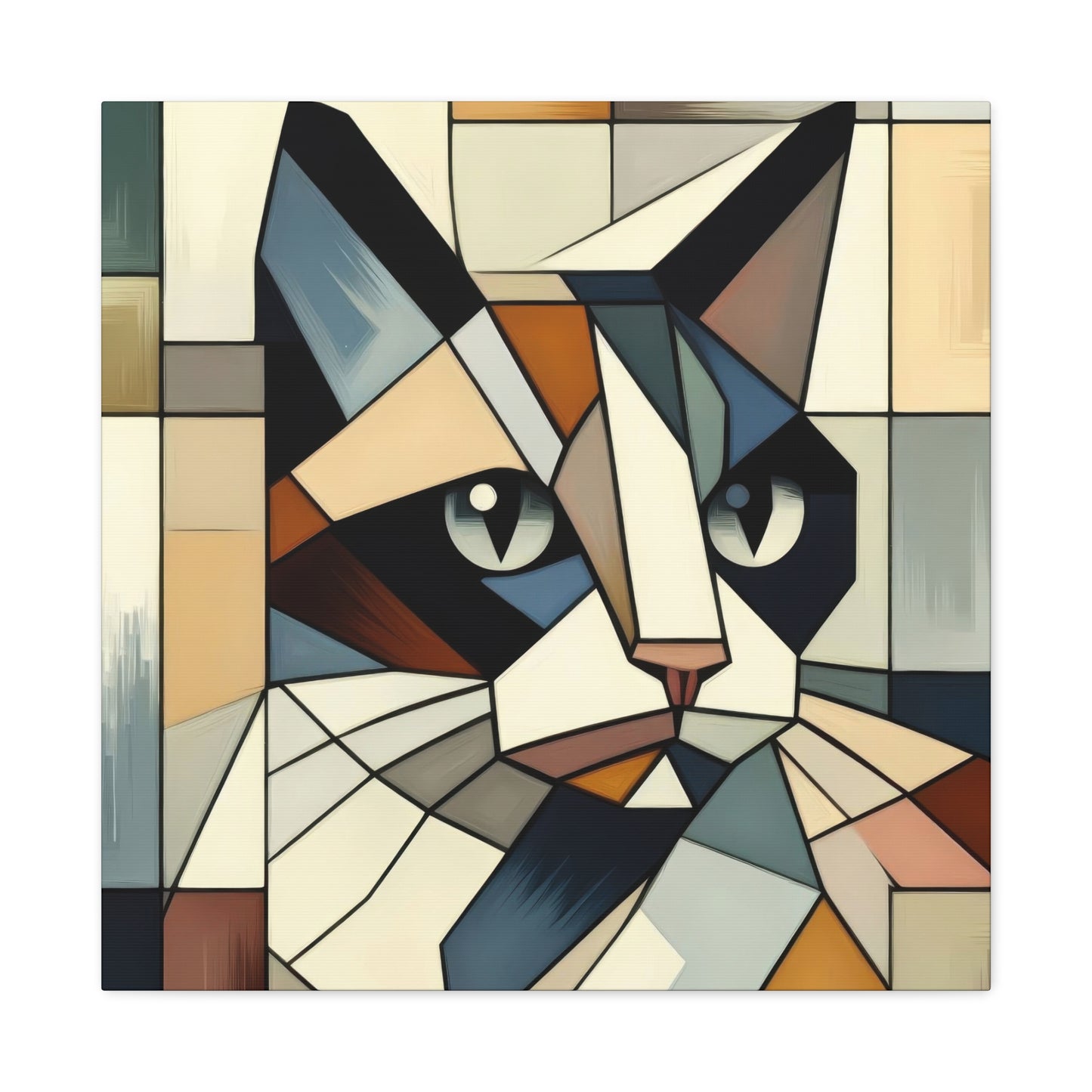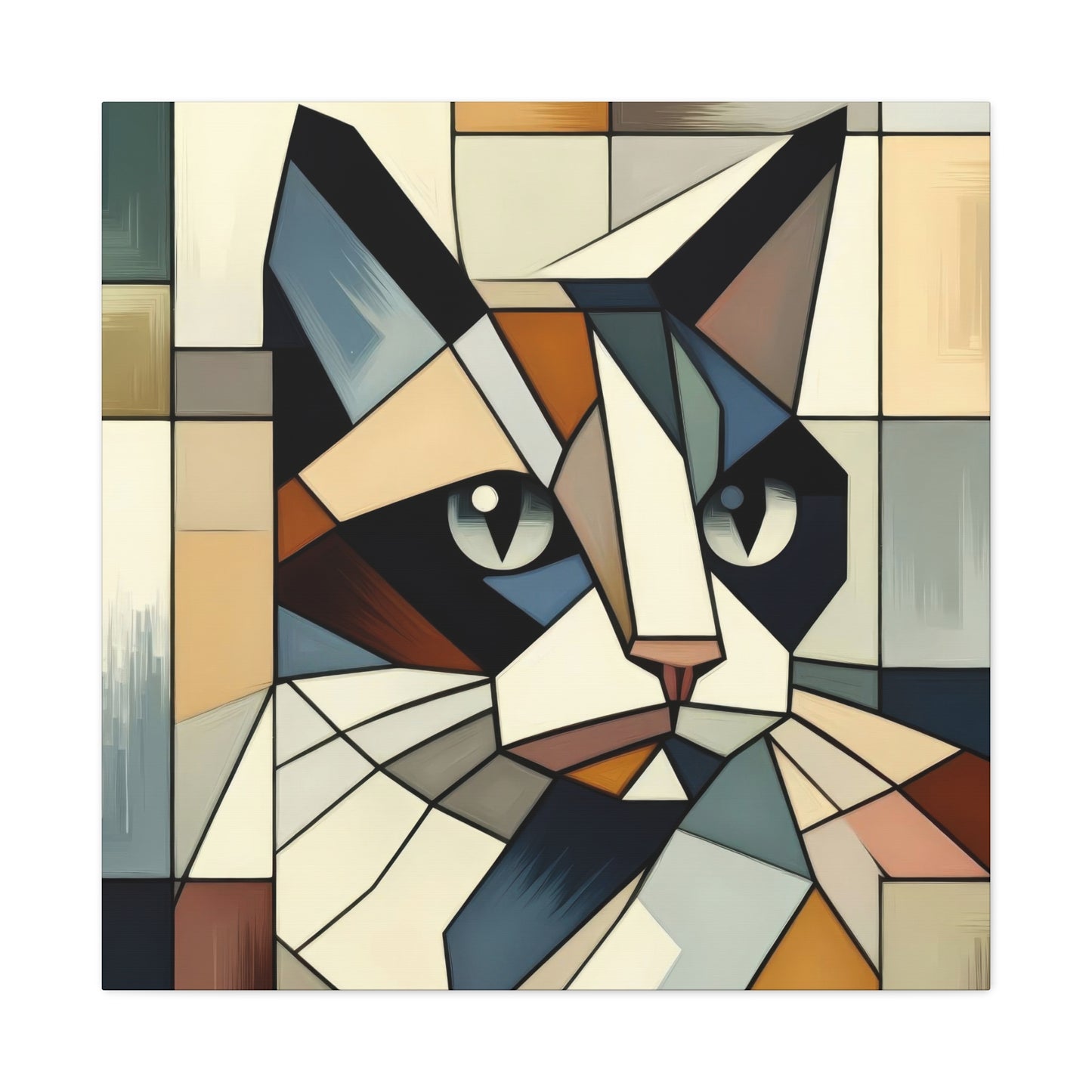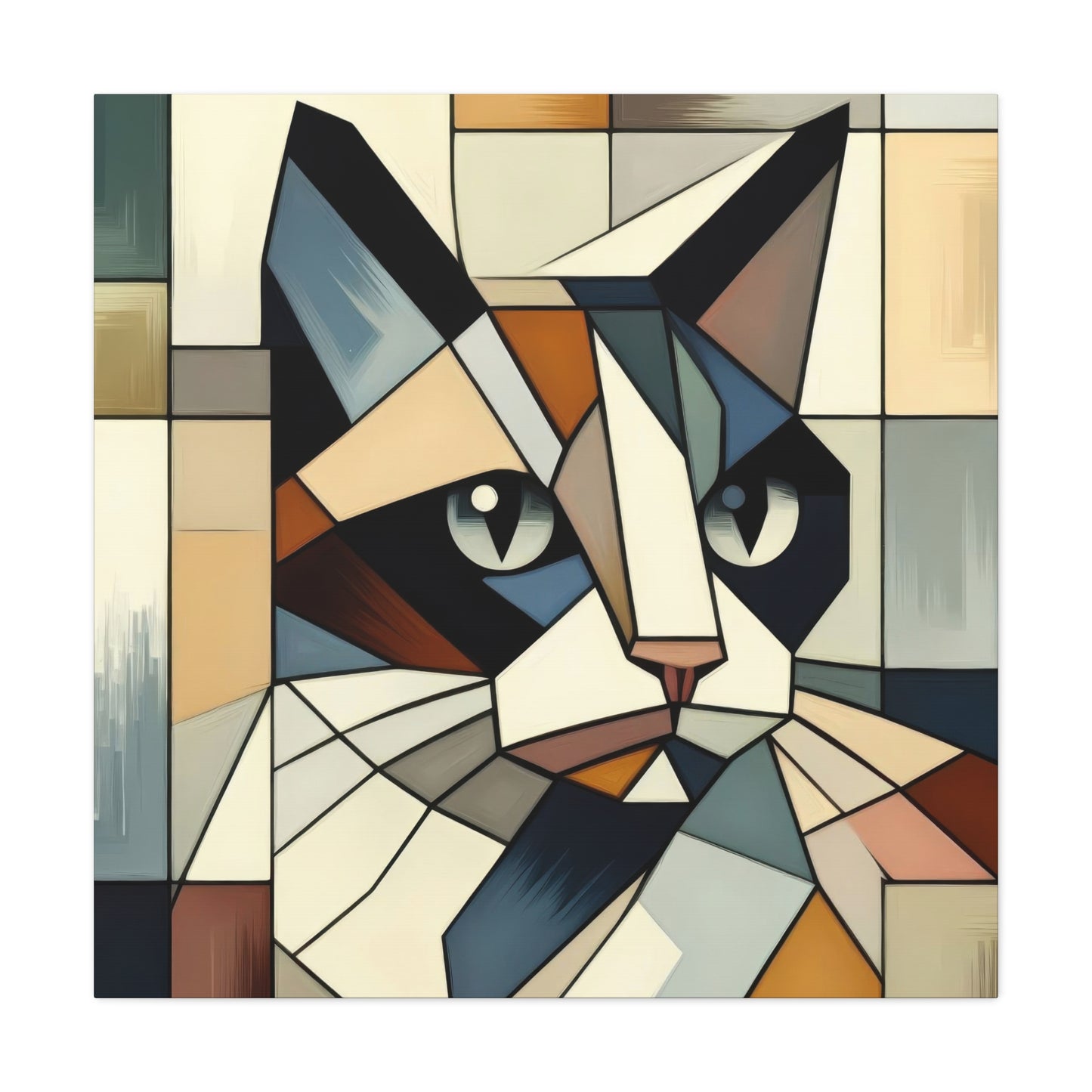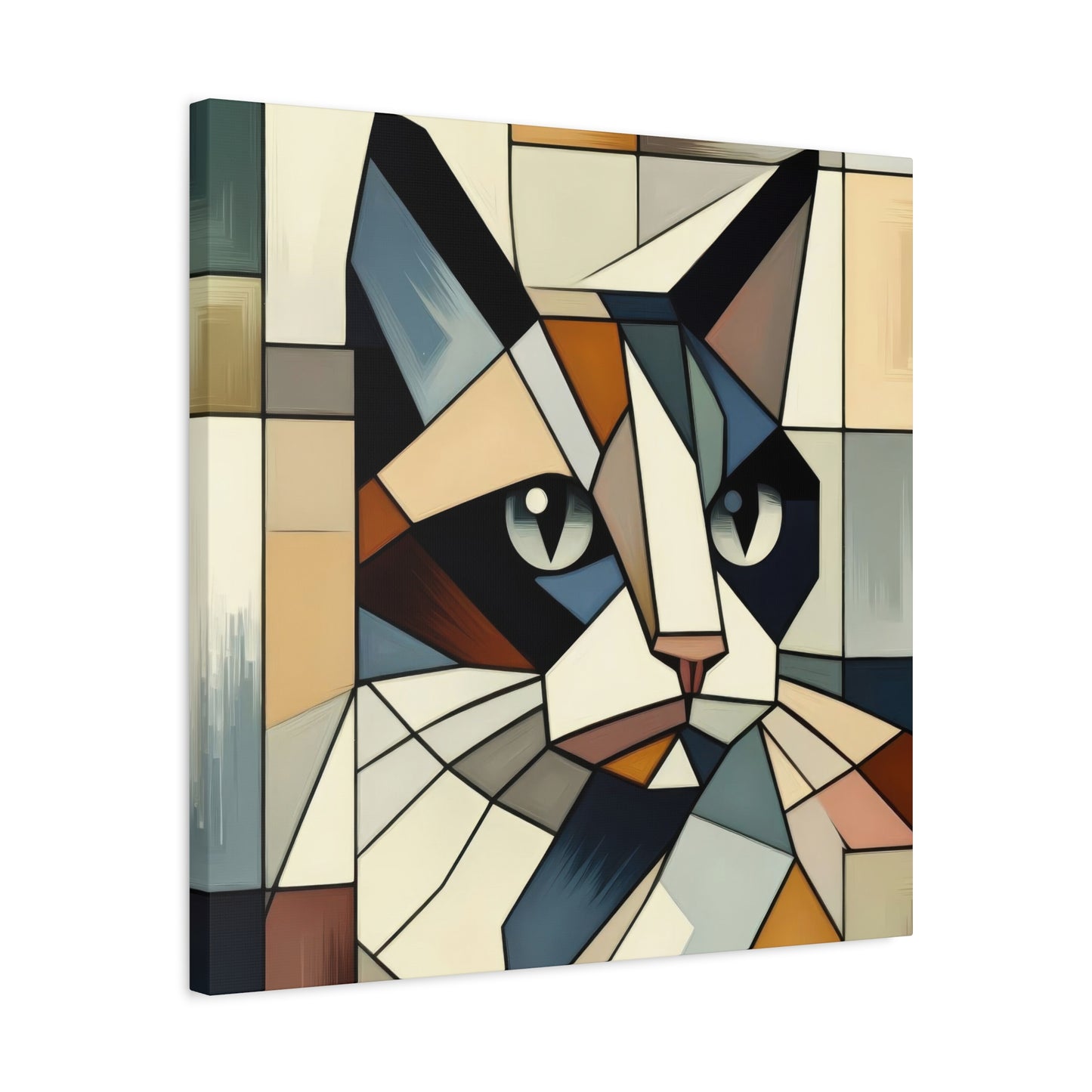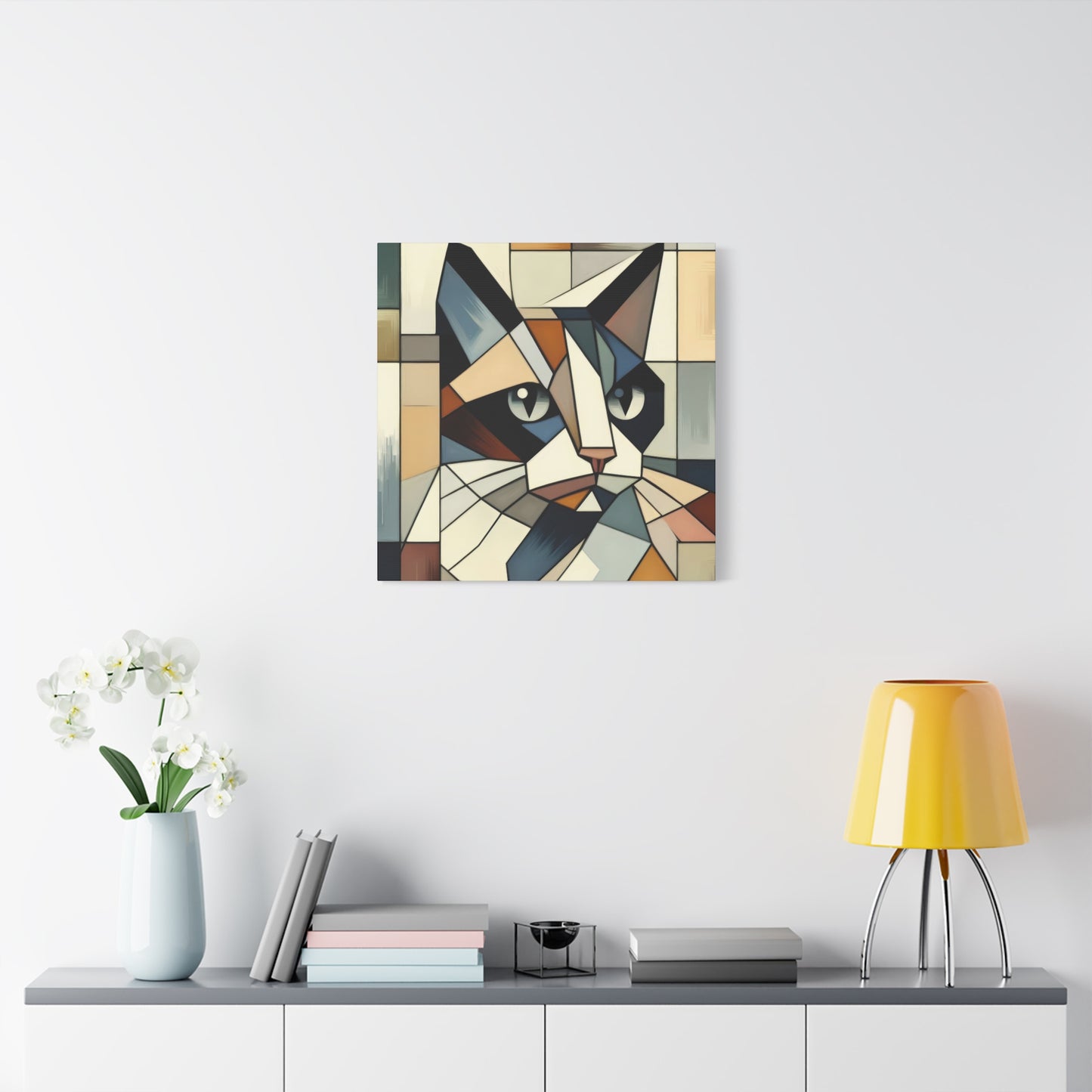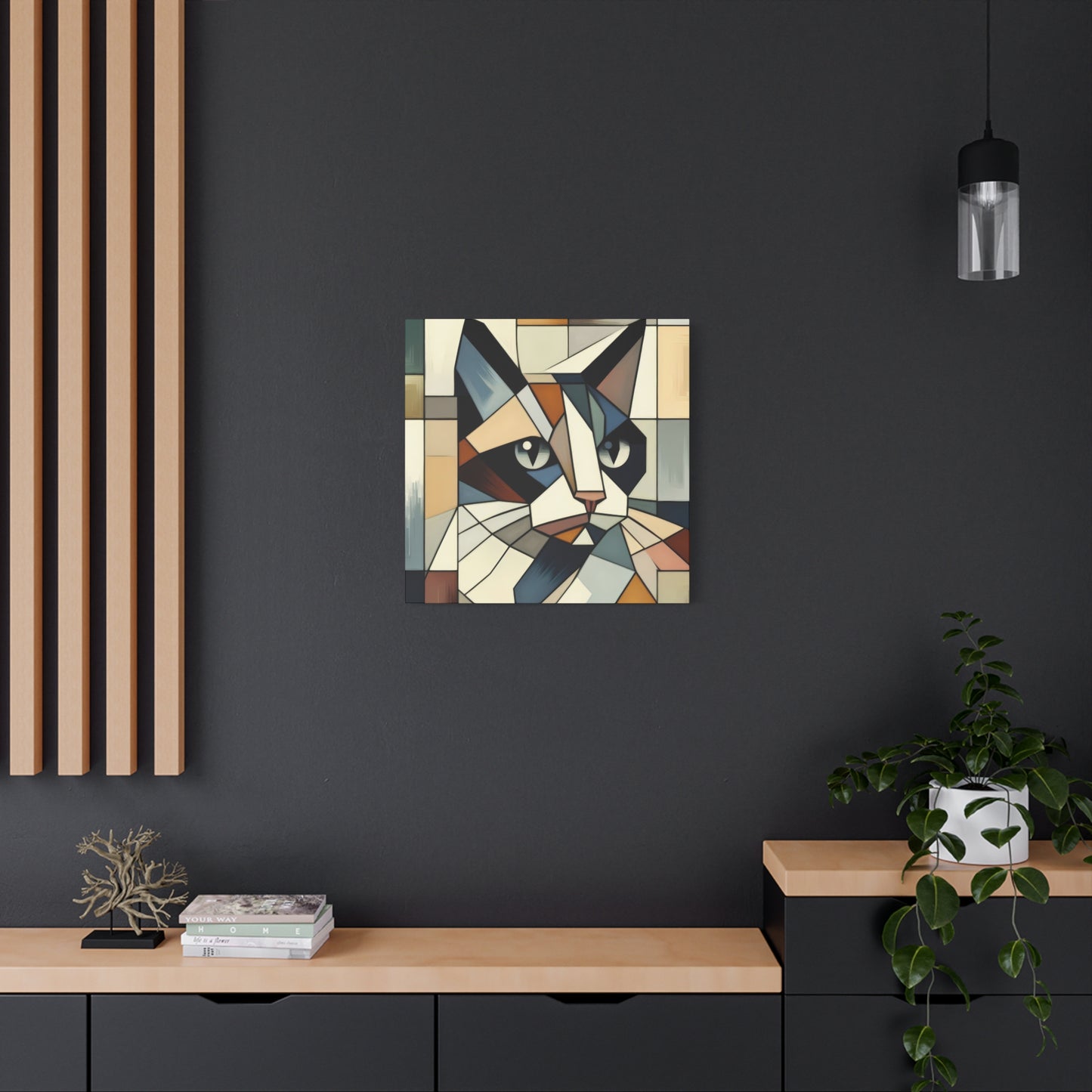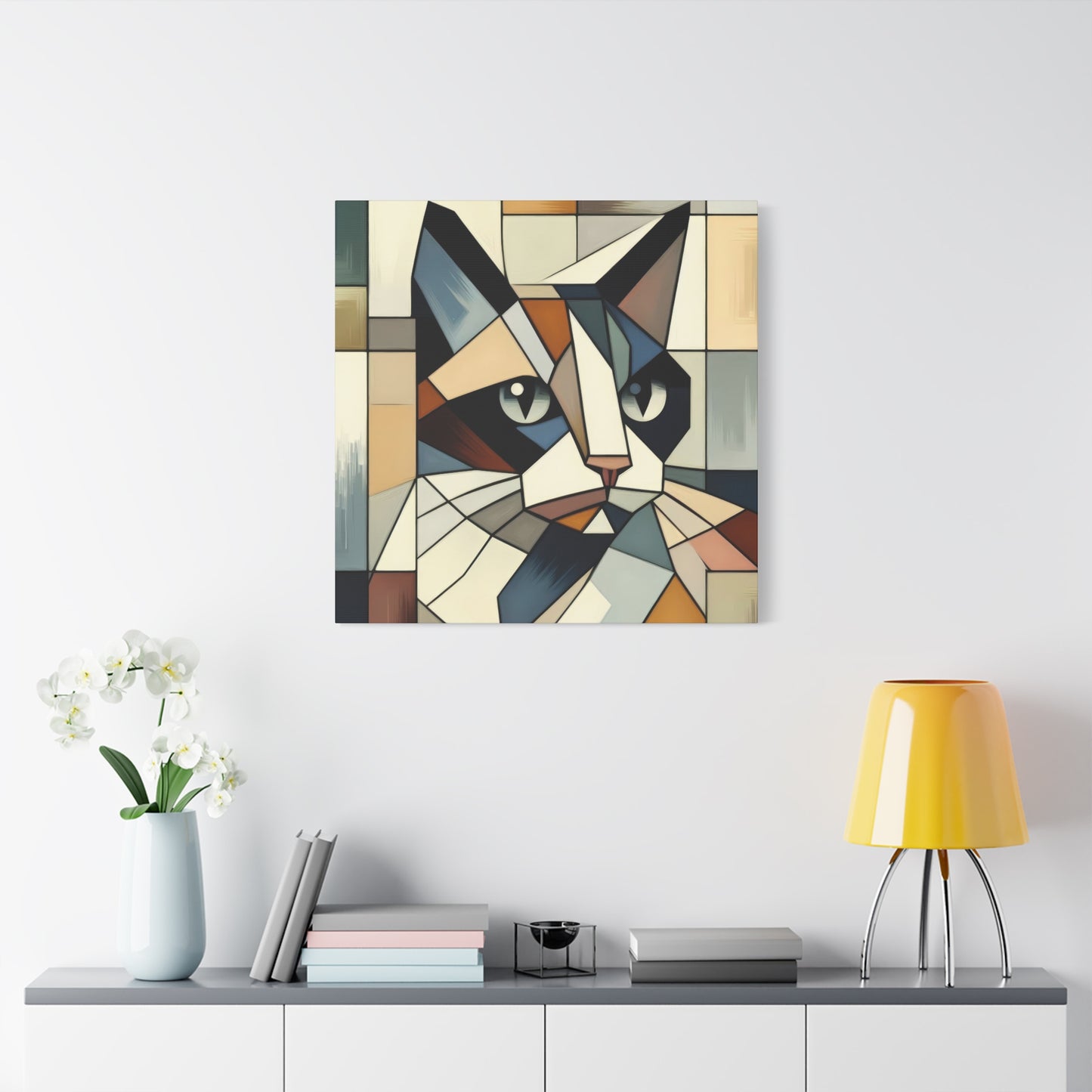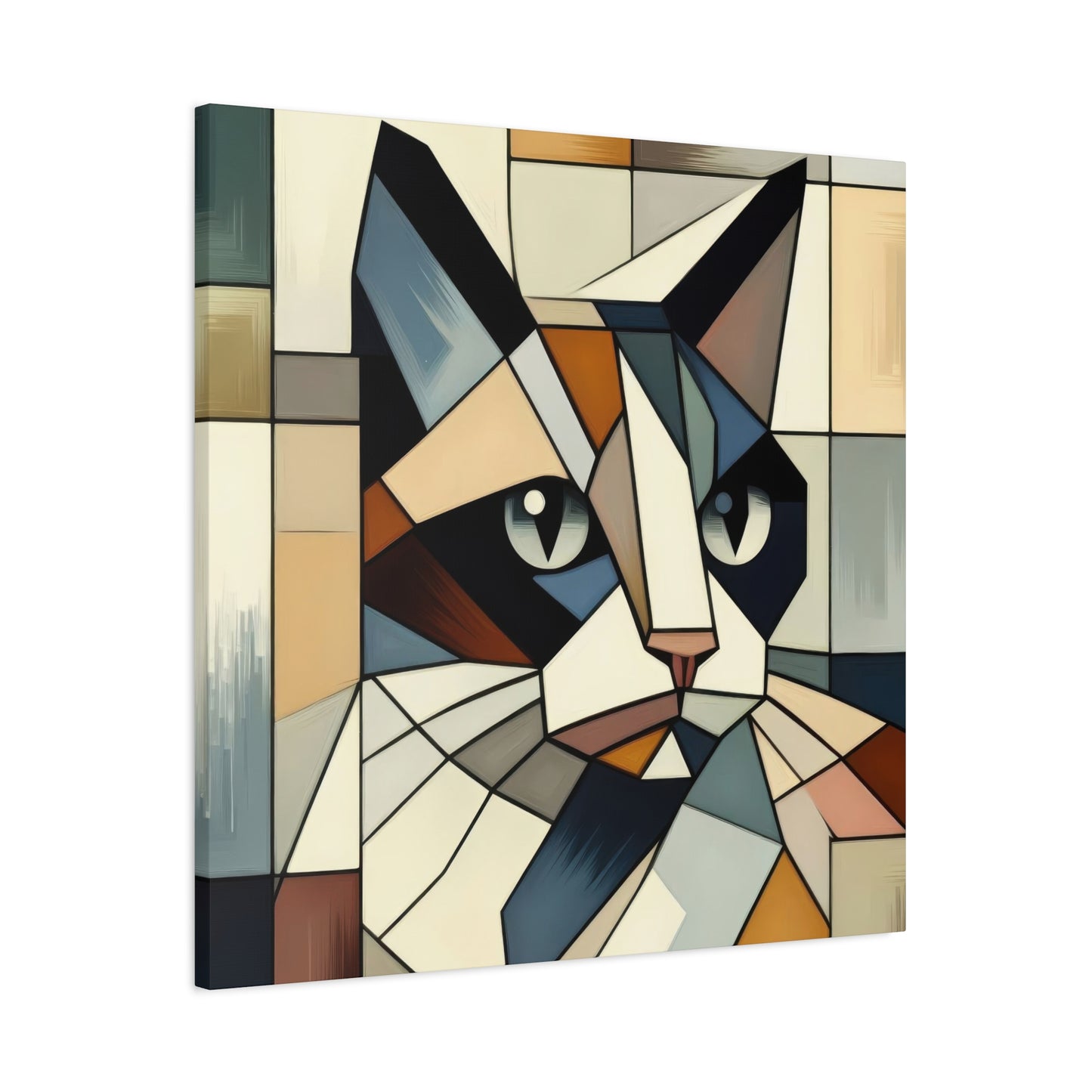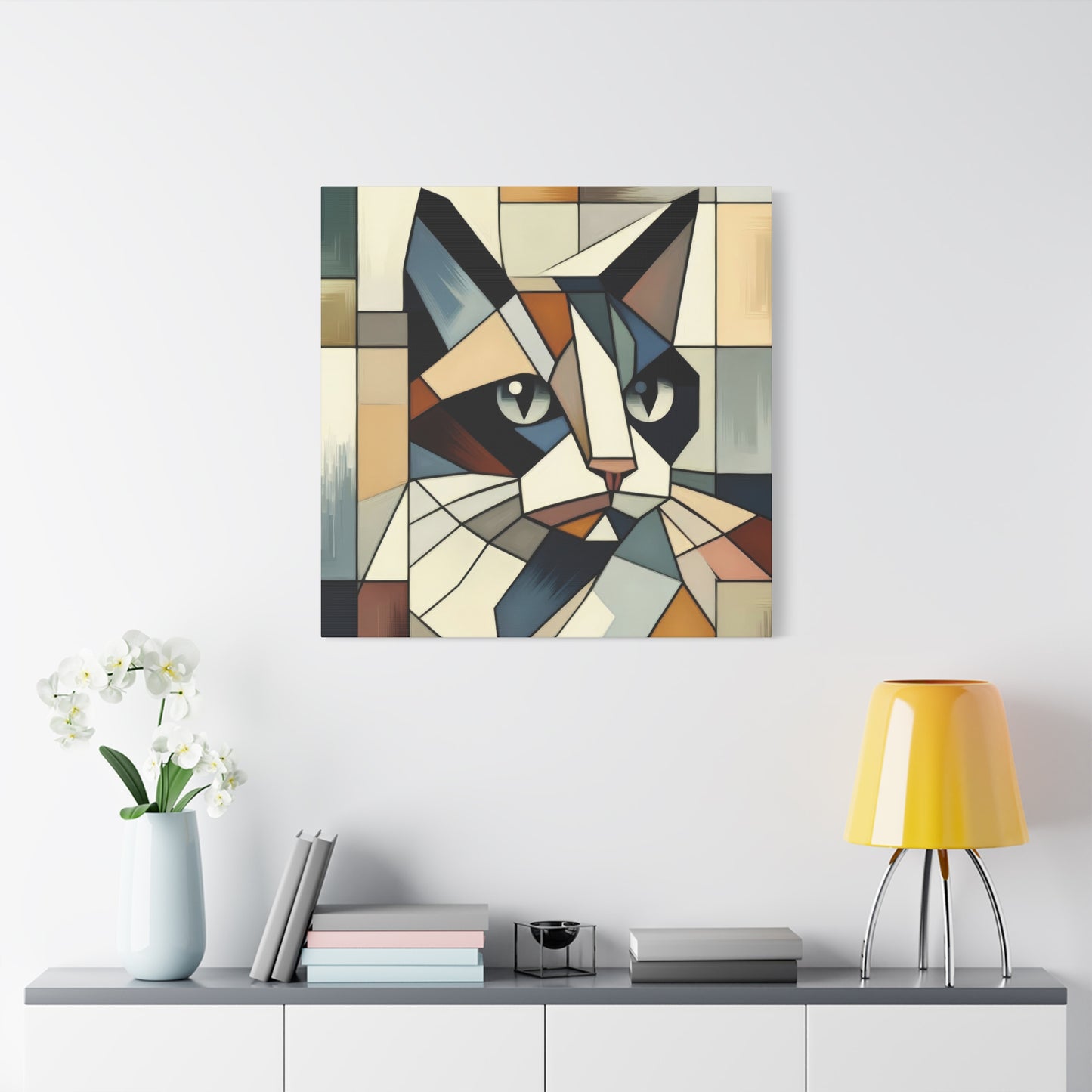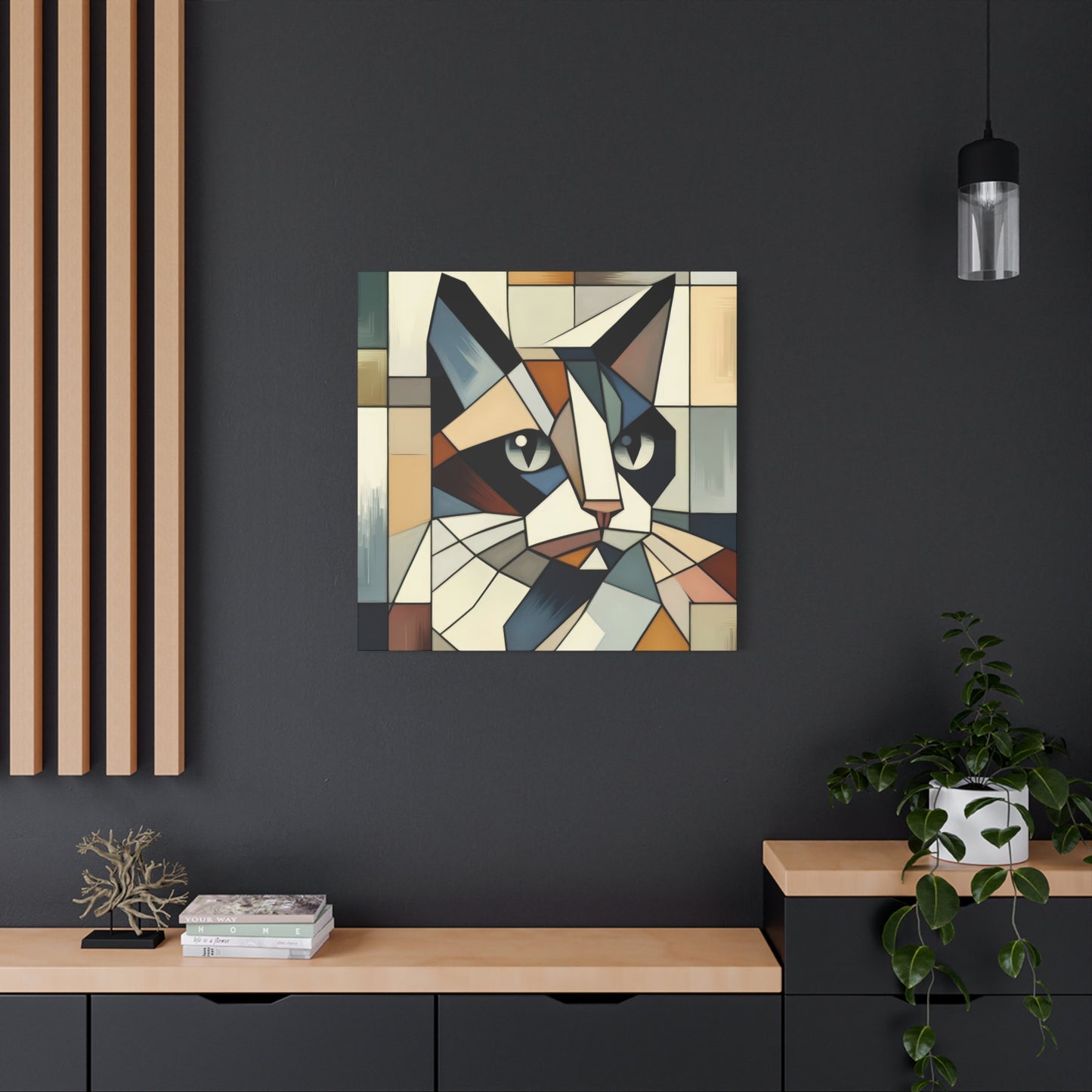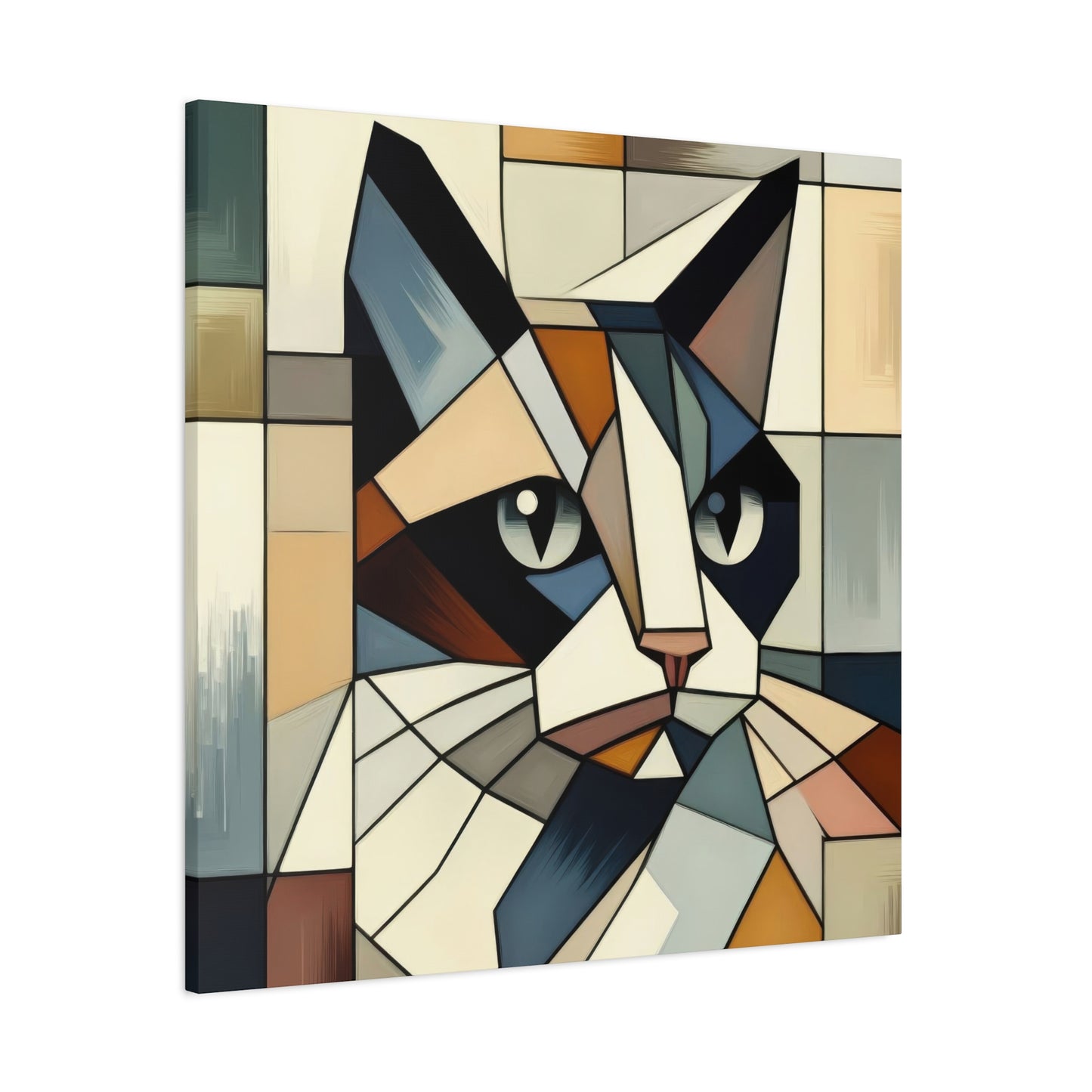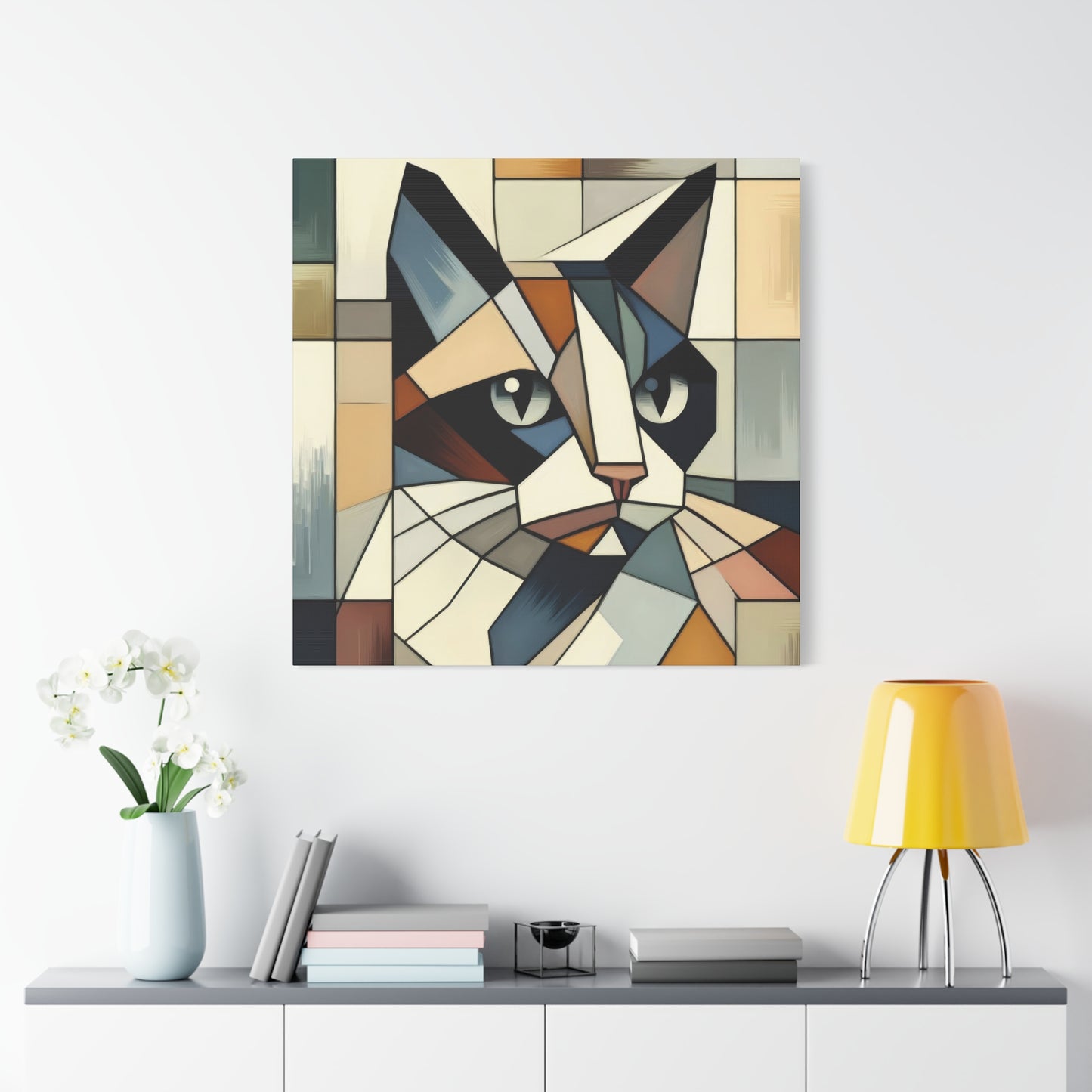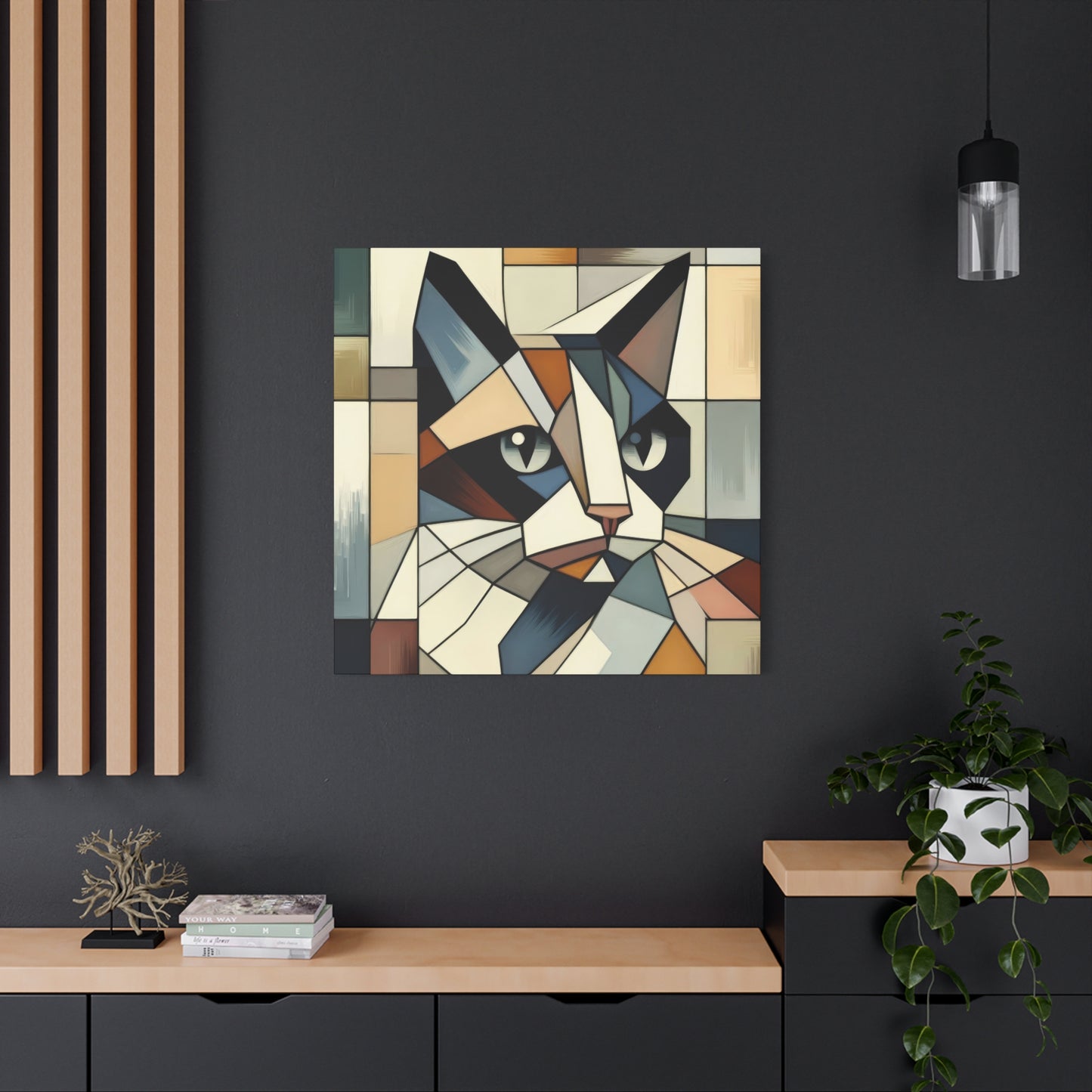Cat Portrait Cubism Wall Art: A Definitive Guide to Geometric Feline Depiction
The domestic cat is a creature of delightful contradictions. It is, at once, a soft, purring companion and a sleek, geometric predator. Its form is fluid as it pours itself from a container, yet it is also a collection of sharp, defined angles: the pyramid of the ears, the triangles of the eyes, the precise daggers of its claws. It is perhaps this inherent duality that makes the cat such an endlessly compelling subject for artists. When this fascinating muse is filtered through the revolutionary lens of Cubism, the result is an art form that is dynamic, intellectually engaging, and visually stunning. A cat portrait cubism wall art piece is more than just a picture of a pet; it is an exploration of form, a deconstruction of identity, and a vibrant statement piece that can transform any living space.
This article delves deep into the world of Cubist feline portraiture. We will move far beyond a simple definition, exploring the historical roots of the movement and why its principles are uniquely suited to capturing the essence, rather than just the appearance, of a cat. We will analyze the techniques artists use to fracture perspective and reassemble it, creating works that show a cat's playful pounce, serene slumber, and haughty gaze all at once. For the homeowner and art lover, we will provide an extensive guide on how to select, style, and integrate these powerful pieces into your home decor, whether you favor minimalist modernism or eclectic bohemia. For the aspiring creator, we will even touch upon the methods for commissioning a custom portrait or beginning your own journey into creating geometric animal art. This is a comprehensive exploration of a niche that sits at the perfect intersection of art history, modern design, and timeless affection for our animal companions.
Unveiling Cubism: The Artistic Revolution Redefined
To understand a cat portrait cubism wall art piece, one must first grasp the profound and seismic shift that Cubism represented in the history of art. Born in the early 20th century from the minds of visionaries like Pablo Picasso and Georges Braque, Cubism was not merely a new style; it was a new way of seeing. For centuries, Western art was dominated by the pursuit of illusion, specifically linear perspective, which aimed to create a convincing, single-viewpoint depiction of a three-dimensional world on a two-dimensional canvas. Cubism deliberately shattered this tradition. It was an intellectual and analytical art form that rejected the idea of a single, fixed viewpoint.
The core principle of Cubism is the representation of a subject from multiple viewpoints simultaneously. Imagine walking around a cat, observing it from the front, from above, and from the side. A traditional artist would pick one of e-these views. A Cubist artist, however, attempts to capture all these perspectives at once, fracturing the subject into its geometric components—cubes, cones, spheres, and cylinders—and reassembling them on the canvas. This process, often called "passage," involves breaking down the boundaries between the subject and its background, merging them into a single, unified geometric tapestry. This approach allows the artist to convey more information about the subject than a simple, naturalistic rendering ever could. It aims to depict the essence and knowledge of the subject, not just its fleeting appearance.
The Feline Muse: Why Cats are a Perfect Subject for Cubist Interpretation
The cat is arguably one of the most suitable muses for the Cubist movement, even more so than many other animals. This suitability stems from the cat's fundamental nature, both in its physical form and in its perceived personality. Physically, a cat is a living study in geometry. Consider the sharp, triangular shapes of its ears, the alert, almond orbs of its eyes, the long, cylindrical tube of its tail, and the defined, angular planes of its face and muzzle. Even a cat at rest often folds itself into a seriescontainer of complex, overlapping shapes. This inherent geometric quality provides a natural starting point for a Cubist artist looking to deconstruct a form.
Beyond the physical, the cat's personality and movement lend themselves perfectly to the Cubist preoccupation with multiple perspectives and the capture of time. A cat is a creature of perpetual motion and sudden stillness. It is the epitome of fluidity, able to leap, twist, and contort its body in ways that defy simple representation. Cubism, with its ability to show multiple movements at once, can capture the idea of a cat's leap—the anticipation, the launch, the twist in mid-air, and the landing—all within a single, static image. This fracturing also mirrors the "fractured" or multifaceted personality of the cat: the aloof observer, the playful hunter, the affectionate companion. A cat portrait cubism wall art piece, therefore, doesn't just show you what a cat looks like; it shows you what it is like to observe a cat in all its complex, contradictory glory.
The Historical Intersection of Cats and Geometric Art
While Pablo Picasso is famous for his Cubist works, his depictions of cats are more often in his other, more naturalistic or surreal styles. However, the cat as a subject was not ignored by his contemporaries or by the artists who followed in the Cubist tradition. Franz Marc, a key figure in German Expressionism but heavily influenced by Cubist principles (specifically the Orphism of Robert Delaunay), used animals, including cats, to convey spiritual and emotional truths, often employing vibrant, non-naturalistic colors and fractured, prismatic forms. His "Cats on a Red Cloth" is a prime example of animal forms being broken down into simpler, more expressive planes.
In the decades that followed, numerous artists have taken up the mantle, applying Cubist techniques specifically to the feline form. The 21st century, in particular, has seen a resurgence of this style, as digital tools and a renewed interest in mid-century modern aesthetics have made it more accessible and popular. The rise of pet culture, where pets are seen as integral family members, has also fueled a desire for pet portraiture that goes beyond traditional, realistic paintings. Owners are seeking art that captures their pet's unique character, and the expressive, dynamic nature of Cubism is perfectly suited to this task. Thus, the modern cat portrait cubism wall art scene is a vibrant one, filled with artists who pay homage to the original masters while bringing their own contemporary sensibilities to the canvas, ensuring the legacy of this geometric style continues to evolve.
Analytical Cubism: The Monochromatic and Intellectual Cat Portrait
Analytical Cubism, pioneered by Pablo Picasso and Georges Braque in the early 20th century, redefined how art could depict reality. It is a style characterized by breaking down subjects into geometric shapes, reassembling them in fragmented, abstracted compositions, and often using a restrained color palette. When applied to feline art, Analytical Cubism transforms the traditional cat portrait into a study of intellectual form and structure, emphasizing the animal’s essence rather than its surface appearance.In an Analytical Cubist cat portrait, the familiar curves of a feline’s body—arched back, pointed ears, or sinuous tail—are dissected into overlapping planes and facets. The monochromatic color scheme, often limited to shades of browns, grays, and muted earth tones, allows the viewer to focus on form, proportion, and spatial relationships rather than being distracted by color. This approach challenges the observer to see the cat in a new way: as an assembly of angles, perspectives, and abstract relationships rather than a single, cohesive image.
Such portraits often evoke an intellectual engagement, inviting viewers to reconstruct the image in their minds, to explore the interplay between light and shadow, depth and flatness. The analytical nature of the style mirrors the contemplative character often attributed to cats themselves—their quiet observation, strategic movements, and inherent mystery. By stripping away color and emphasizing structural geometry, the Analytical Cubist cat portrait becomes more than representation; it becomes a meditation on perception, form, and the layered complexity of an everyday subject.In essence, Analytical Cubism elevates the cat from mere subject to an intellectual puzzle, demonstrating how abstract techniques can reveal hidden dimensions of familiar beings. It’s a celebration of form over surface and thought over sensation, reflecting the cerebral, enigmatic qualities inherent in feline companions.
Synthetic Cubism: Introducing Vibrant Color and Texture to Feline Art
While Analytical Cubism focused on dissecting form in muted tones, Synthetic Cubism embraced color, texture, and a playful sense of reconstruction. Emerging as the next evolution in the Cubist movement around 1912–1914, Synthetic Cubism reintegrated the visual elements broken down by Analytical Cubism, creating more approachable, vibrant compositions. When applied to feline art, this style transforms the cat portrait into a lively, expressive, and multidimensional experience.In a Synthetic Cubist cat portrait, the artist introduces vivid colors, patterned surfaces, and varied textures. Collage techniques—such as layering paper, fabric, or painted elements—can create a tactile sense that mirrors a cat’s fur, eyes, and physical presence. Rather than focusing solely on intellectual analysis, the style celebrates the sensory qualities of the subject. Cubist planes intersect with bursts of color, turning ears, tails, and whiskers into vibrant geometric motifs that command attention while still maintaining a recognizable feline form.
This approach allows artists to experiment with abstraction and reality simultaneously. The viewer recognizes the cat, yet the composition invites curiosity: bright patches of color suggest movement, patterned shapes imply fur textures, and playful juxtapositions emphasize the dynamic, independent personality of the animal. Synthetic Cubism highlights a cat’s expressive qualities—its elegance, curiosity, and mischief—through visual complexity, rather than through literal depiction.By combining geometry with texture and chromatic richness, Synthetic Cubism in feline art bridges intellect and emotion. It honors the analytical rigor of its predecessor while celebrating the joyful experimentation of color and material. The result is a cat portrait that feels alive, multidimensional, and interactive—a visual dance of form, color, and creativity that reflects both the artistry of the painter and the spirited essence of the cat itself.
The Role of Color Theory in Expressing a Cat's Personality
Color theory plays a vital role in art by guiding the emotional and psychological impact of color combinations. In feline art, particularly in modern and Cubist interpretations, color becomes a key tool for conveying a cat’s unique personality traits. Unlike realistic depictions, which focus on lifelike representation, artists can manipulate hue, saturation, and contrast to capture the mood, temperament, and energy of their feline subjects.Warm colors such as reds, oranges, and yellows can evoke a sense of playfulness, curiosity, or mischievousness, reflecting an active or lively cat. Conversely, cooler tones like blues, greens, and purples can communicate calm, mystery, or a contemplative nature, aligning with a more reserved or introspective feline. Complementary colors create visual tension and dynamism, often used to depict a cat’s unpredictable or agile nature, while analogous color schemes can emphasize harmony and serenity, highlighting gentle, affectionate qualities.
Beyond the choice of hue, saturation and value are equally important. Bold, highly saturated colors may suggest confidence, energy, or extroversion, whereas muted or pastel tones convey subtlety, elegance, or gentleness. Even the interplay of light and shadow in color gradients can suggest depth of personality: the way light reflects in a cat’s eyes, the subtle shading of its fur, or the contrast between foreground and background can reveal aspects of temperament, mood, or movement.In Cubist and abstract interpretations, color theory often becomes even more expressive. Fragmented shapes and planes can carry emotional weight through their chromatic choices, allowing the artist to explore multiple facets of a cat’s personality simultaneously. By carefully selecting and juxtaposing colors, an artist can transform a static portrait into a vivid narrative, capturing not just the physical appearance of a cat, but the essence of its character, energy, and spirit.
Beyond Picasso and Braque: Other Artists Who Explored Feline Cubism
While Pablo Picasso and Georges Braque pioneered Cubism, their explorations of form and abstraction opened doors for other artists to experiment with the movement in unique ways. Among these, several artists applied Cubist principles specifically to feline subjects, exploring the intersection of geometry, emotion, and animal personality in innovative ways.Fernand Léger, for instance, often used bold, tubular forms and simplified shapes in his works, sometimes incorporating animals including cats into his compositions. His approach combined the analytical breakdown of form with a playful, almost industrial aesthetic, emphasizing structure while introducing dynamic color schemes that reflected movement and energy. Similarly, Juan Gris, known for his precise and orderly Cubist compositions, translated feline forms into a meticulous interplay of geometric shapes and harmonious planes. Cats in Gris’s works often appear almost architectural, embodying balance, elegance, and rhythm through their abstracted forms.
Beyond early 20th-century masters, contemporary artists have embraced Cubist-inspired feline art with even more experimentation. Modern illustrators and painters often blend traditional Cubist fragmentation with digital techniques, vibrant color palettes, and mixed media to create feline portraits that emphasize personality, mood, and narrative. These artists take inspiration from Picasso and Braque’s structural explorations but expand them with contemporary tools, incorporating texture, collage, and expressive color to convey the playful or mysterious nature of cats.Even sculptors and ceramicists have explored Cubist feline representations, turning abstract planes into three-dimensional interpretations that engage viewers from multiple angles. By doing so, they emphasize the multifaceted personality of cats, making the viewer experience the animal in space, not just on a flat canvas.
Geometric Abstraction versus Cubism in Modern Cat Art
Geometric Abstraction and Cubism are often intertwined in modern art, but they differ in philosophy, technique, and visual effect, especially when applied to feline subjects. Both styles deconstruct forms into geometric shapes, yet their intentions and outcomes diverge. Understanding these distinctions can deepen appreciation for contemporary cat art.Geometric Abstraction focuses primarily on the use of basic shapes, lines, and colors to create visually striking compositions. In cat art, this approach often emphasizes symmetry, patterns, and balance over literal representation. A cat rendered in Geometric Abstraction might be reduced to triangles, circles, and rectangles, arranged in harmonious or rhythmic patterns that evoke the essence of a feline without relying on realistic features. The color palette may be bold or minimalistic, serving more as a compositional tool than a narrative device. Emotional and conceptual qualities are implied through structure and form rather than overt depiction.
Cubism, on the other hand, is inherently analytical. Originating with Picasso and Braque, it seeks to portray multiple perspectives simultaneously, breaking a subject into fragmented planes that interact in complex ways. In a Cubist cat portrait, one might see overlapping profiles, faceted eyes, and segmented bodies, all combined in a cohesive yet abstract whole. Analytical Cubism emphasizes form and perspective, often with muted colors, while Synthetic Cubism introduces color and texture to reassemble the fragmented elements into dynamic compositions. Cubism conveys not just structure but the multidimensional personality and movement of the cat.While both styles embrace abstraction, Geometric Abstraction leans toward formal elegance and pattern, whereas Cubism emphasizes perceptual complexity and intellectual engagement. Modern cat artists often blend elements of both, using geometric clarity to complement Cubist fragmentation, producing works that are visually dynamic yet conceptually rich. Recognizing these differences allows collectors and enthusiasts to appreciate the intent behind the shapes, planes, and colors in feline-inspired contemporary art.
Key Elements to Look for in a High-Quality Cubist Cat Print
A high-quality Cubist cat print is more than just a decorative image; it is a work of art that balances abstraction, composition, and emotional resonance. To select or evaluate one, certain elements serve as essential indicators of craftsmanship and authenticity.First, the treatment of form is critical. A Cubist cat print should reflect thoughtful fragmentation of the subject, with multiple perspectives visible in the composition. The overlapping planes, angular shapes, and faceted features should feel deliberate rather than chaotic, capturing the essence of the cat while maintaining a harmonious visual rhythm. Attention to geometric relationships, symmetry, and proportion often distinguishes a refined print from a simplistic interpretation.Second, color and texture play a vital role, especially in Synthetic Cubist-inspired prints. Look for a palette that enhances depth, emotion, and dimension without overpowering the structural integrity of the composition. Texture—whether simulated brush strokes, collaged elements, or digital layering—adds tactile richness and visual intrigue, contributing to the liveliness of the feline subject.
Third, the quality of print reproduction matters. High-resolution printing preserves details, sharp lines, and subtle tonal variations essential for conveying Cubist complexity. Archival-quality inks and paper ensure longevity, preventing fading or deterioration over time. Limited edition prints or signed works by recognized artists add collectible value and authenticity.Finally, the overall composition should evoke a sense of movement or personality. Even in abstracted, faceted forms, a successful Cubist cat print communicates the cat’s essence—its elegance, curiosity, or playfulness—through the interaction of planes, color, and perspective.In essence, a high-quality Cubist cat print combines technical precision, thoughtful abstraction, and expressive energy. Collectors should seek works that balance analytical structure with visual appeal, capturing both the geometric artistry and the enigmatic character of the feline subject.
Choosing Your Cat Portrait Cubism Wall Art: A Buyer's Guide
Selecting the perfect Cubist cat portrait for your home involves balancing aesthetic appeal, artistic quality, and personal resonance. Cubist art, with its fragmented forms and abstract planes, requires careful consideration to ensure the piece complements your space while capturing the essence of your feline muse.Begin by evaluating the style of Cubism represented in the artwork. Analytical Cubist portraits, often monochromatic and structurally complex, highlight form and perspective. They are ideal for viewers who appreciate intellectual depth and subtlety in design. Synthetic Cubist portraits, on the other hand, incorporate vibrant colors, textures, and mixed-media elements, bringing playful energy and dynamic presence to the cat subject. Understanding which approach resonates with your taste helps narrow your options.
Next, consider the composition and emotional impact. High-quality Cubist cat art balances fragmented planes with recognizable feline traits, allowing you to connect emotionally with the piece. Examine the interplay of angles, perspectives, and color—does it evoke curiosity, elegance, or whimsy? The artwork should reflect not only artistic skill but also the personality of the cat, making it more than a decorative object.Material and print quality are also essential. Look for archival-grade prints, canvas, or original works with precise reproduction of color, line, and texture. Signed or limited-edition pieces often carry added value and authenticity.Finally, assess how the piece integrates with your interior. Consider wall size, lighting, and existing décor to ensure the Cubist portrait enhances the environment rather than overwhelming it. By thoughtfully combining style, emotional resonance, and quality, buyers can select a Cubist cat portrait that is both a visual delight and a lasting investment in their home aesthetic.
Integrating Large-Scale Cubist Cat Art as a Statement Piece
Large-scale Cubist cat art has the power to dominate a room, transforming it into a gallery-like space and serving as an immediate visual focal point. These statement pieces are particularly effective in modern or minimalist interiors, where the abstract geometric forms and fragmented planes can command attention without competing with other décor elements.When choosing a large-scale piece, proportion is crucial. The artwork should fit the wall space comfortably, neither dwarfing the room nor appearing lost in a vast expanse. Large Cubist portraits often highlight the cat’s expressive features—faceted eyes, angular body forms, and dynamic planes—allowing viewers to appreciate details that might be overlooked in smaller works.Color selection plays a significant role. Bold, vibrant Synthetic Cubist pieces can energize a space, while monochromatic Analytical Cubist works offer sophistication and intellectual depth.
Placement should consider sightlines: large artworks are most effective when positioned at eye level or slightly above, ensuring that the fragmented forms and intricate details are easily observed.Lighting enhances the visual impact of large-scale Cubist cat art. Soft directional lighting or spotlights can accentuate textures, shadows, and geometric planes, emphasizing the multi-dimensional quality of the composition. Additionally, surrounding décor should be understated, allowing the statement piece to shine without distraction.Integrating large-scale Cubist feline art transforms a simple wall into a conversation starter. The interplay of geometric abstraction, bold color, and the enigmatic presence of the cat captivates viewers, creating a sense of drama and sophistication. A well-chosen statement piece not only elevates interior design but also celebrates the artistry and personality inherent in feline-inspired Cubist work.
Using Small-Scale Cubist Feline Prints for Subtle Accents
Small-scale Cubist cat prints offer versatility and charm, allowing art lovers to introduce feline-inspired abstraction without overwhelming a space. These prints are ideal for subtle accents in homes, offices, or personal nooks, where they provide visual interest and artistic flair in a restrained, approachable way.When using small-scale Cubist prints, consider grouping multiple pieces to create a cohesive mini-gallery. Arranging Analytical and Synthetic Cubist works together can highlight contrasts between monochromatic structure and colorful vibrancy, offering layered visual storytelling. Even a single print can enrich a shelf, desk, or side table, bringing personality and sophistication to intimate spaces.Color and composition remain critical, even at smaller sizes. A muted palette can integrate seamlessly with neutral interiors, while a splash of vivid color can act as a focal accent in an otherwise subdued environment.
The geometric planes and fragmented shapes of Cubism ensure that even compact artworks retain visual intrigue and intellectual depth, encouraging viewers to engage closely with the details.Small-scale prints also offer flexibility in framing and placement. Simple frames can highlight the modern, abstract qualities of the work, while creative mounts or floating frames can enhance depth and texture. Because of their size, these prints can be repositioned easily, rotated seasonally, or mixed with other art forms, allowing for dynamic interior arrangements.Ultimately, small-scale Cubist feline art brings subtle sophistication and playful abstraction to any setting. It allows collectors and enthusiasts to celebrate the charm, complexity, and personality of cats while enhancing their space with a touch of modern artistic expression, proving that even modestly sized works can make a memorable impression.
How to Match Cubist Art with Different Interior Design Styles
Cubist art, with its abstract planes, geometric fragmentation, and bold experimentation with form and color, can dramatically transform a living space. However, successfully integrating such dynamic pieces into a home requires understanding how they interact with various interior design styles. By considering scale, color palette, and thematic resonance, you can harmonize Cubist art with almost any décor.In modern minimalist interiors, where neutral palettes and clean lines dominate, Cubist pieces serve as powerful focal points. A monochromatic Analytical Cubist cat portrait, for instance, complements the minimalist ethos, adding intellectual depth without visual clutter. The key is restraint: one or two well-placed artworks can anchor a room while maintaining the calm simplicity of the overall space.
In contemporary or modern interiors, where vibrant accents and statement pieces are welcome, Synthetic Cubist art comes alive. Bold colors, layered textures, and geometric abstractions energize a room while reflecting the dynamic nature of modern design. Pairing such artwork with sleek furniture, metallic finishes, or glass surfaces amplifies the contemporary feel, creating a dialogue between structure and color.For industrial or loft-style spaces, with exposed brick, concrete, and raw materials, Cubist art can soften harsh textures while maintaining an urban edge. Monochromatic or muted Synthetic Cubist prints echo the industrial palette, while the geometric fragmentation introduces visual interest and conceptual depth. Placing these pieces against neutral or rugged backdrops highlights their angular forms and draws attention to the intricate interplay of shape and perspective.
Traditional or transitional interiors may seem less compatible at first glance, but thoughtful curation bridges the gap. Smaller-scale Cubist cat prints, framed in classic wood or metal, can punctuate a wall gallery without overwhelming traditional elements. The juxtaposition of abstract geometry and conventional furnishings creates a conversation between eras, blending historical charm with modern artistic expression.Color coordination is essential in any setting. In rooms with vibrant textiles or patterned surfaces, choosing Cubist works with complementary or muted tones ensures cohesion. Conversely, in monochromatic spaces, a pop of color from Synthetic Cubist art provides dramatic contrast.Ultimately, matching Cubist art with interior design is about balance. By considering scale, color, and style, homeowners can ensure their abstract feline pieces enhance, rather than clash with, their environment. Whether subtle or bold, Cubist art offers endless versatility, allowing each space to reflect personality, sophistication, and a love of modern artistic exploration.
The Modern Minimalist Home and the Abstract Feline
Minimalist homes celebrate simplicity, clean lines, and the “less is more” philosophy, making them an ideal canvas for Cubist cat art. In such spaces, abstract feline portraits—whether Analytical or Synthetic Cubist—can act as a single striking element that elevates the room without introducing visual chaos.Analytical Cubist portraits, with their monochromatic palettes and structured planes, complement the minimalist ethos perfectly. They introduce intellectual intrigue while maintaining the restrained color schemes typical of minimalist interiors. A faceted cat eye or a fragmented body silhouette, rendered in subtle shades of gray, beige, or muted browns, draws attention to form and perspective rather than decorative detail. The result is a meditative, thought-provoking focal point that aligns seamlessly with minimalist principles.
Synthetic Cubist cats, which employ vibrant colors and textured surfaces, can also enhance minimalist spaces, but with a more dynamic, playful energy. Strategic placement—such as a single large-scale print on a blank wall—creates a bold contrast against neutral furnishings, adding personality without clutter. Accent pieces like throw pillows or rugs in complementary hues can further tie the artwork into the room’s aesthetic.Scale and proportion are crucial in minimalist interiors. Oversized Cubist pieces should be paired with open wall space, allowing geometric planes to “breathe,” while small-scale prints can provide subtle focal points in reading nooks, hallways, or above minimalist shelving. Lighting also plays a key role: natural light or directed spotlights can enhance the texture, shadow, and dimensionality of the artwork, emphasizing the abstract complexity of the feline subject.
The abstract feline motif also resonates conceptually with minimalism. Cats themselves symbolize elegance, independence, and quiet observation—qualities echoed in the minimal design philosophy. A Cubist cat portrait, whether monochromatic or color-rich, brings a sophisticated, contemplative energy to the home, bridging artistic abstraction with the serenity of minimalist living.In essence, the modern minimalist home provides the perfect stage for abstract feline art. By carefully considering style, scale, color, and placement, homeowners can transform blank walls into curated galleries that celebrate both simplicity and the intellectual allure of Cubist design.
Eclectic and Bohemian Spaces: A Perfect Haven for Cubist Art
Eclectic and Bohemian interiors thrive on individuality, vibrant patterns, and unexpected juxtapositions, making them an ideal setting for Cubist cat art. These spaces encourage creativity and visual experimentation, allowing both Analytical and Synthetic Cubist works to shine amid layered textures, diverse textiles, and curated collectibles.In a Bohemian environment, Synthetic Cubist cat portraits with bold colors and mixed-media textures complement the energy and playfulness of the décor. Bright geometric planes and faceted feline forms can harmonize with patterned rugs, tapestries, and vibrant cushions, creating a cohesive yet dynamic visual narrative. Layering multiple Cubist pieces in different sizes allows for a gallery wall effect that mirrors the free-spirited essence of Bohemian design.
Analytical Cubist works, though more subdued, also find their place in eclectic spaces. Their structural sophistication offers balance amid visual complexity, providing moments of pause in rooms filled with diverse patterns and objects. A monochromatic cat portrait framed in a rustic or vintage frame can bridge the gap between abstract art and the eclectic aesthetic, blending intellectual depth with tactile warmth.Placement and arrangement are crucial in these expressive interiors. Cubist prints can be mixed with other art forms, vintage finds, and natural elements to create curated vignettes. The key is intentional layering: positioning art to draw the eye while maintaining a sense of flow ensures the room remains visually stimulating without becoming chaotic.
Color harmony is flexible in Bohemian and eclectic spaces. Contrasts, complementary tones, and unexpected pairings are encouraged, allowing Cubist cat art to interact playfully with textiles, wall colors, and decorative objects. This interplay reinforces the personality and dynamism of both the feline subject and the interior as a whole.Ultimately, eclectic and Bohemian interiors provide an open canvas for Cubist art to flourish. Abstract feline portraits contribute intellectual intrigue, vibrant energy, and artistic sophistication, enhancing the whimsical, curated, and deeply personal nature of these spaces. The result is a home that celebrates individuality, creativity, and the enduring charm of the abstract cat.
Creating a Thematic Gallery Wall with Animal Cubism
A gallery wall is a dynamic way to showcase art, offering a curated narrative while transforming a blank wall into a focal point. When the theme revolves around animal Cubism, particularly feline subjects, it allows for a sophisticated blend of abstraction, geometry, and personality, creating a space that is both visually stimulating and conceptually engaging.The first step in designing a thematic gallery wall is selecting the artwork. Consider a combination of Analytical and Synthetic Cubist pieces: Analytical works with monochromatic planes provide structure and balance, while Synthetic works with vibrant colors and textures inject energy and playfulness. Including different scales—small, medium, and large prints—creates depth and a sense of rhythm, encouraging the eye to move across the wall.
Next, think about layout and composition. Symmetrical arrangements create a sense of order, complementing minimalist or contemporary interiors. Asymmetrical or salon-style layouts, with varied spacing and mixed frame styles, enhance the eclectic and Bohemian feel. To unify the gallery, maintain consistency through a recurring motif, such as cats, other animals, or geometric patterns, which ties disparate pieces together without restricting creative freedom.Frames and presentation matter as well. Sleek, minimal frames work well with modern interiors, while vintage or textured frames can enhance the charm of more eclectic spaces. Floating frames or canvas wraps allow the artwork to visually “pop,” emphasizing the abstraction and fragmented planes characteristic of Cubist art.
Lighting is a crucial component for a gallery wall. Track lighting, adjustable spotlights, or wall-mounted lamps can highlight individual pieces while enhancing the three-dimensional effect of the geometric planes. Shadows and highlights created by lighting interact with the fragmented forms, amplifying the sense of depth and movement within the Cubist compositions.Finally, consider interactivity and storytelling. Group pieces that tell a narrative about feline behavior, personality, or movement. By juxtaposing Analytical and Synthetic Cubist works, viewers are invited to explore different interpretations of the same subject, reflecting both intellectual abstraction and emotional vibrancy.A thematic gallery wall of animal Cubism transforms a simple space into an artistic journey. It celebrates the playful, mysterious, and elegant qualities of animals, particularly cats, while embracing the intellectual and aesthetic depth of Cubist abstraction. With careful curation, layout, and lighting, the wall becomes both a personal expression and a compelling conversation piece.
Abstract Art: Its Impact on Your Mood and Space
Abstract art, including Cubist representations of animals, has a profound effect on both emotional states and the perception of physical space. Unlike representational art, which depicts subjects realistically, abstract works focus on shapes, colors, lines, and textures, engaging viewers on cognitive, emotional, and sensory levels. Understanding its impact allows collectors and enthusiasts to make intentional design choices that enhance their living environments.Color plays a central role in shaping mood. Warm tones like reds, oranges, and yellows can energize a room, stimulating creativity, activity, and conversation. Cool tones such as blues, greens, and purples promote calm, introspection, and relaxation. In Cubist feline art, color interacts with geometric fragmentation to evoke different emotional responses. Bright, vibrant Synthetic Cubist compositions may inject playfulness and vitality, while muted Analytical Cubist works create a contemplative, sophisticated atmosphere.
Shape and form also influence perception. Angular, faceted planes typical of Cubism can energize a space, adding a sense of movement and complexity. Rounded or flowing shapes in abstract works provide softness and fluidity, creating a soothing environment. The arrangement and layering of geometric elements can visually expand or contract a room, making it feel more spacious or intimate depending on the composition.Texture, both visual and tactile, further affects spatial perception. Thick brushstrokes, layered media, or digital textures in abstract pieces can add depth, drawing viewers into the work and enhancing the dimensionality of the surrounding space. Even in flat prints, illusionistic shading and intersecting planes create a dynamic interplay between foreground and background, adding richness to interior design.
Psychologically, abstract art encourages personal interpretation and engagement. Viewers project emotions, memories, and ideas onto the composition, making the experience unique and interactive. This open-ended nature can stimulate imagination, foster reflection, and create an environment that feels intellectually and emotionally vibrant.Incorporating abstract art into a home or office thus shapes both mood and spatial perception. By carefully selecting pieces that harmonize with color schemes, lighting, and architectural features, homeowners can cultivate energy, calm, or intrigue. Whether through Cubist feline portraits or other abstract forms, art becomes a tool to influence atmosphere, evoke emotion, and transform everyday spaces into immersive, expressive environments.
Commissioning a Custom Cubist Portrait of Your Pet
A custom Cubist portrait of your pet is more than just artwork—it is a unique celebration of personality, form, and artistic interpretation. Cubist art, with its fragmented planes, geometric abstraction, and multiple perspectives, provides a distinctive lens through which to depict your beloved animal, particularly cats, dogs, or other pets with expressive features. Commissioning a custom piece allows you to translate your pet’s character into a visual language that is both sophisticated and deeply personal.The process begins with selecting the style of Cubism that resonates with you. Analytical Cubism, characterized by muted tones and structural complexity, emphasizes form and perspective. It’s ideal if you prefer a subtle, intellectual, and contemplative aesthetic. Synthetic Cubism, by contrast, incorporates vibrant colors, textures, and layered media, capturing dynamic energy and playful personality traits. Deciding which style best reflects your pet’s essence helps guide the artist in shaping the final composition.
Providing reference materials is essential. High-quality photographs from multiple angles allow the artist to study your pet’s unique features—facial expressions, posture, and characteristic movements. Some artists also encourage sharing behavioral notes, favorite toys, or quirky habits, which can influence the design and inject personality into the abstract forms.Size and medium should be determined early in the process. Canvas, paper, or digital formats each offer different visual and tactile experiences. Consider where the artwork will be displayed—large canvases make bold statements, while smaller prints or mixed-media works can be integrated into gallery walls or personal spaces.
Communication is critical throughout the commission. Discuss timelines, draft sketches, revisions, and color palettes with your artist to ensure alignment on vision and execution. Many artists offer iterative feedback, allowing you to approve compositions or adjustments while maintaining the integrity of the Cubist abstraction.Finally, a custom Cubist portrait is more than decoration—it is a lasting tribute to your pet. By blending abstraction, color, and form, it captures not just appearance but personality, mood, and energy. The finished work becomes an intimate and sophisticated expression of your bond, offering a visual narrative that honors your pet in a unique, modernist style. Commissioning such a piece is a rewarding experience that combines art, emotion, and individuality in every geometric plane and faceted surface.
How to Find and Vet an Artist for Your Custom Portrait
Finding the right artist for a custom Cubist portrait is as important as choosing the style and medium. The goal is to identify a professional whose skills, aesthetic sensibilities, and working process align with your vision for a personalized piece.Start by researching artists who specialize in Cubism or abstract animal art. Online platforms, social media channels like Instagram, artist marketplaces, and portfolio websites are excellent resources. Focus on those who display consistency in style, technical skill, and creativity. Pay attention to previous commissions and note whether their work conveys personality, emotion, and precision in abstract compositions.Reviews and testimonials are crucial. Feedback from past clients can provide insight into the artist’s professionalism, reliability, and communication style. Positive experiences with deadlines, responsiveness, and collaborative processes indicate a higher likelihood of a smooth commissioning process.Once potential artists are shortlisted, evaluate their portfolio quality. Look for clarity in their abstract compositions, mastery of geometric forms, effective use of color and texture, and the ability to capture subject personality. Specifically for pet portraits, consider whether their past work demonstrates sensitivity to animal features—eyes, posture, and subtle expressions—within Cubist abstraction.Communication and collaboration are key.
Reach out to artists to discuss your vision, providing photos, personality notes, and size preferences. Ask about their process, timelines, revisions policy, and pricing. A professional artist will welcome discussion, clarify expectations, and suggest solutions to translate your pet’s personality into Cubist abstraction.Additionally, consider practical details such as medium, shipping, and payment terms. Confirm that the artist uses archival-quality materials and offers clear agreements to protect both parties.Ultimately, vetting an artist combines aesthetic discernment, professional reliability, and collaborative compatibility. The right artist will not only deliver a visually compelling Cubist pet portrait but also make the commissioning experience enjoyable and engaging. By carefully researching, reviewing portfolios, and establishing open communication, you can ensure that your custom piece is a lasting tribute that captures your pet’s unique character in a modern, abstract style.
What to Provide an Artist for a Successful Commission
Commissioning a custom Cubist portrait of your pet is an exciting opportunity to transform a beloved companion into a piece of sophisticated art. To ensure the process runs smoothly and the final artwork reflects your vision, providing the artist with detailed, thoughtful information is essential. The quality of communication at this stage often determines the success of the commission.High-Quality Reference Photos: Clear, detailed images of your pet from multiple angles are the foundation of any successful portrait. Include front, side, and top views, as well as shots that capture distinct features like eye shape, ear position, tail posture, or unique markings. Images that showcase your pet in different moods—playful, relaxed, curious—help the artist capture personality within the abstract Cubist forms. Lighting should be consistent to allow accurate interpretation of color, fur patterns, and textures.
Behavioral Notes and Personality Traits: Sharing insights into your pet’s temperament, habits, and quirks allows the artist to infuse the portrait with character. Mention playful antics, favorite resting positions, or subtle expressions that define your pet’s individuality. In Cubist art, which fragments and reinterprets form, these personality cues guide the abstraction, ensuring the final piece resonates with your pet’s unique essence.Style Preferences: Clarify the type of Cubism you prefer—Analytical or Synthetic. Analytical Cubism emphasizes structural planes, muted palettes, and intellectual abstraction, while Synthetic Cubism embraces vibrant colors, texture, and layered geometric elements. Providing examples of existing works you admire helps the artist understand your aesthetic goals and desired level of abstraction.Size, Medium, and Placement: Specify the intended dimensions of the artwork and the medium—canvas, paper, digital print, or mixed media. Knowing where the piece will be displayed informs scale, composition, and color choices.
For example, large wall-mounted portraits may benefit from bold, dynamic shapes, while smaller prints may focus on intimate details.Inspirational References and Themes: If you have a vision for color schemes, background elements, or complementary décor, share visual references. Mood boards, sketches, or images of other artworks can communicate ideas more effectively than words alone.Practical Details: Confirm timelines, budget, and revisions policy upfront. Understanding deadlines, expected iterations, and final deliverables helps prevent miscommunication and ensures a professional workflow.By providing comprehensive references, personality insights, style guidance, and practical information, you equip the artist to translate your pet into a Cubist masterpiece accurately and creatively. The more detailed and thoughtful the input, the higher the likelihood of a final portrait that not only reflects your vision but also captures the distinctive spirit and charm of your pet. A successful commission is the result of collaboration, clarity, and mutual understanding between client and artist.
Conclusion
The fascination with Cat Portrait Cubism Wall Art lies in its innovative fusion of feline elegance and geometric abstraction, offering a fresh and compelling approach to animal-inspired décor. By reimagining the familiar form of cats through the lens of cubism, this art style transforms ordinary feline portraits into dynamic compositions of shapes, lines, and angles. The result is a visually engaging aesthetic that challenges conventional perceptions while capturing the essence and personality of the cat in a uniquely artistic manner. This approach elevates wall art beyond simple representation, offering a sophisticated and contemporary statement piece for modern interiors.
At its core, cubist cat art celebrates both form and abstraction. Unlike realistic depictions that focus solely on likeness, cubism deconstructs the subject into geometric planes, overlapping perspectives, and fragmented angles, allowing viewers to experience multiple facets of the feline subject simultaneously. This creates a sense of movement, depth, and visual complexity that mirrors the mysterious, agile, and unpredictable nature of cats themselves. By exploring the interplay between structure and spontaneity, cubist cat portraits invite deeper engagement and interpretation, making them not only visually intriguing but intellectually stimulating as well.
From an interior design perspective, cat cubism wall art is highly versatile and adaptable. Large canvases can serve as bold focal points in living rooms, bedrooms, or home offices, instantly infusing a space with energy, creativity, and personality. Smaller prints can be incorporated into gallery walls or paired with complementary décor elements, adding sophistication and a modern edge without overwhelming the space. The use of vibrant colors, bold contrasts, and layered textures commonly found in cubist compositions allows these artworks to harmonize with a variety of interior styles, including contemporary, minimalist, eclectic, and even bohemian settings. They offer an easy way to introduce both color and artistic depth to any room.
Beyond its aesthetic contribution, cubist cat artwork conveys symbolic and emotional resonance. Cats have long represented independence, curiosity, grace, and mystery — qualities that are accentuated and abstracted in cubist depictions. The fragmented geometric forms reflect the multifaceted personalities of cats, capturing their enigmatic presence in a way that is both playful and contemplative. For art enthusiasts and cat lovers alike, these pieces provide a connection to the animal’s character while also offering a thought-provoking visual experience. In doing so, cubist feline art transforms interior spaces into environments that encourage imagination, reflection, and admiration.
The artistry behind cubist cat portraits demonstrates technical skill and creative vision. Artists often employ bold lines, layered shapes, and vibrant or contrasting colors to define forms while suggesting movement and emotion. Some compositions integrate abstract backgrounds, geometric patterns, or color-blocking techniques to further enhance depth and visual interest. This blend of abstraction and detail ensures that each piece stands as a unique work of art, capable of captivating viewers whether they approach it from an aesthetic, emotional, or intellectual perspective. The dynamic interplay of geometry and feline form exemplifies the transformative power of contemporary art.
Moreover, incorporating cubist feline art into home décor allows for both artistic expression and personal storytelling. These pieces serve as conversation starters, focal anchors, and sources of inspiration, reflecting the homeowner’s taste, appreciation for creativity, and affinity for cats. They are equally suited for residential and professional spaces, where they can inject vibrancy, sophistication, and a sense of modern artistry. Unlike conventional animal portraits, cubist cat art challenges perceptions, celebrates abstraction, and transforms walls into multidimensional narratives.
In conclusion, Cat Portrait Cubism Wall Art is a striking synthesis of geometry, emotion, and feline charm. It transcends traditional portraiture to create visually stimulating, intellectually engaging, and emotionally resonant artworks that enrich any interior.Ultimately, embracing geometric feline wall art allows homeowners, collectors, and design enthusiasts to transform ordinary spaces into dynamic, creative environments. It celebrates the mystery, elegance, and character of cats while offering a bold, modern aesthetic that merges art and décor seamlessly. Through its innovative approach, cubist cat portraits redefine the possibilities of animal-inspired art, turning walls into canvases of personality, abstraction, and contemporary sophistication.

















